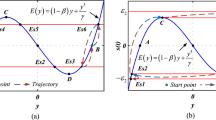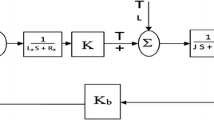Abstract
This paper develops a general output error identification approach of nonlinear synchronous generator parameters. The considered method is based on a meta-heuristic optimization algorithm called stochastic fractal search (SFS). It consists of minimizing a quadratic criterion that represents the squared difference between the simulated model outputs and those obtained from the model to be identified by using the SFS algorithm. To highlight the performance of the proposed method, a deep comparison with the PSO algorithm was carried out. The obtained results proved the superiority of the proposed approach in terms of stability, robustness, estimation accuracy and convergence speed.











Similar content being viewed by others
References
Aghamolki, H. G., Miao, Z., Fan, L., Jiang, W., & Manjure, D. (2015). Identification of synchronous generator model with frequency control using unscented Kalman filter. Electric Power Systems Research, 126, 45–55. https://doi.org/10.1016/j.epsr.2015.04.016.
Al-Hamadi, H., & EL-Naggar, K. (2010). Measurement of synchronous machine parameters using Kalman filter based fuzzy logic estimator. Measurement, 43(10), 1327–1335. https://doi.org/10.1016/j.measurement.2010.07.012.
Arjona, M. A., Cisneros-Gonzalez, M., & Hernandez, C. (2011). Parameter estimation of a synchronous generator using a sine cardinal perturbation and mixed stochastic-deterministic algorithms. IEEE Transactions on Industrial Electronics, 58(2), 486–493.
Belqorchi, A., Karaagac, U., Mahseredjian, J., & Kamwa, I. (2019). Standstill frequency response test and validation of a large hydrogenerator. IEEE Transactions on Power Systems, 34(3), 2261–2269. https://doi.org/10.1109/tpwrs.2018.2889510.
Boutalis, Y., Theodoridis, D., Kottas, T., & Christodoulou, M. A.(2014). In M. J. Grimble & M. A. Johnson (Eds.), System Identification and Adaptive Control, ser. Advances in Industrial Control. Cham: Springer. https://doi.org/10.1007/978-3-319-06364-5.
Çelik, E. (2018). Incorporation of stochastic fractal search algorithm into efficient design of PID controller for an automatic voltage regulator system. Neural Computing and Applications, 30(6), 1991–2002. https://doi.org/10.1007/s00521-017-3335-7.
Cisneros-Gonzalez, M., Hernandez, C., Escarela-Perez, R., & Arjona, M. A. (2011). Determination of equivalent-circuit parameters of a synchronous generator based on the standstill DC decay test and a hybrid optimization method. Electric Power Components and Systems, 39(7), 645–659. https://doi.org/10.1080/15325008.2010.536808.
Dehghani, M., & Karrari, M. (2007). Nonlinear robust modeling of synchronous generators. Iranian Journal of Science and Technology, Transaction B: Engineering, 31(6), 629–640.
Dehghani, M., Karrari, M., Rosehart, W., & Malik, O. P. (2010). Synchronous machine model parameters estimation by a time-domain identification method. Electrical Power and Energy Systems, 32(5), 524–529. https://doi.org/10.1016/j.ijepes.2009.07.010.
Dehghani, M., & Nikravesh, S. K. (2008). Nonlinear state space model identification of synchronous generators. Electric Power Systems Research, 78(5), 926–940.
Dubey, H. M., Pandit, M., & Panigrahi, B. (2018). An overview and comparative analysis of recent bio-inspired optimization techniques for wind integrated multi-objective power dispatch. Swarm and Evolutionary Computation, 38, 12–34. https://doi.org/10.1016/j.swevo.2017.07.012.
Fan, L., & Wehbe, Y. (2013). Extended Kalman filtering based real-time dynamic state and parameter estimation using PMU data. Electric Power Systems Research, 103, 168–177. https://doi.org/10.1016/j.epsr.2013.05.016.
Gutiérrez Rodríguez, G., Silveira e Silva, A., & Zeni, N. (2017). Identification of synchronous machine parameters from field flashing and load rejection tests with field voltage variations. Electric Power Systems Research, 143, 813–824. https://doi.org/10.1016/j.epsr.2016.08.025.
Hosseini, S. M. (2018). The operation and model of UPQC in voltage sag mitigation using EMTP by direct method. Emerging Science Journal, 2(3). https://doi.org/10.28991/esj-2018-01138.
IEEE guide for test procedures for synchronous machines part I acceptance and performance testing part II test procedures and parameter determination for dynamic analysis. IEEE Std 115-2009 (Revision of IEEE Std 115-1995), pp. 1–219, May 2010.
Karrari, M., & Malik, O. (2005). Identification of synchronous generators using adaptive wavelet networks. International Journal of Electrical Power & Energy Systems, 27(2), 113–120.
Kennedy, J., & Eberhart, R. (1995) Particle swarm optimization. https://doi.org/10.1109/icnn.1995.488968.
Khalaf, T. Z., Çağlar, H., Çağlar, A., & Hanoon, A. N. (2020). Particle swarm optimization based approach for estimation of costs and duration of construction projects. Civil Engineering Journal, 6(2), 384–401. https://doi.org/10.28991/cej-2020-03091478.
Khalilpourazari, S., Naderi, B., & Khalilpourazary, S. (2019). Multi-objective stochastic fractal search: A powerful algorithm for solving complex multi-objective optimization problems. Soft Computing, 24(4), 3037–3066. https://doi.org/10.1007/s00500-019-04080-6.
Khosravi, S., Zamanifar, M., and Derakhshan-Barjoei, P.(2018). Analysis of bifurcations in a wind turbine system based on DFIG. Emerging Science Journal, 2(1). https://doi.org/10.28991/esj-2018-01126.
Kou, P., Zhou, J., Wang, C., Xiao, H., Zhang, H., & Li, C. (2011). Parameters identification of nonlinear state space model of synchronous generator. Engineering Applications of Artificial Intelligence, 24(7), 1227–1237. https://doi.org/10.1016/j.engappai.2011.05.012.
Kundur, P. (1993). Power system stability and control. London: McGraw Hill.
Lai, L., & Ma, J. (1996). Application of evolutionary programming to transient and subtransient parameter estimation. IEEE Transactions on Energy Conversion, 11(3), 523–530.
Liu, L., Liu, W., & Cartes, D. A. (2008). Particle swarm optimization-based parameter identification applied to permanent magnet synchronous motors. Engineering Applications of Artificial Intelligence, 21(7), 1092–1100.
Liu, W., Liu, L., Chung, I.-Y., & Cartes, D. A. (2011). Real-time particle swarm optimization based parameter identification applied to permanent magnet synchronous machine. Applied Soft Computing, 11(2), 2556–2564. https://doi.org/10.1016/j.asoc.2010.08.022.
Ma, J. (1995). Generator parameter identification using evolutionary programming. International Journal of Electrical Power & Energy Systems, 17(6), 417–423.
Meghnous, A. R., Pham, M. T., & Lin-Shi, X. (2013). Dynamic identification of a synchronous machine using an extended sliding mode observer. Mathematics and Computers in Simulation, 90, 45–59. https://doi.org/10.1016/j.matcom.2012.05.020.
Mellal, M. A., & Zio, E. (2016). A penalty guided stochastic fractal search approach for system reliability optimization. Reliability Engineering & System Safety, 152, 213–227. https://doi.org/10.1016/j.ress.2016.03.019.
Mosbah, H., & El-Hawary, M. (2017). Optimization of neural network parameters by stochastic fractal search for dynamic state estimation under communication failure. Electric Power Systems Research, 147, 288–301. https://doi.org/10.1016/j.epsr.2017.03.002.
Mouni, E., Tnani, S., & Champenois, G. (2008). Synchronous generator modelling and parameters estimation using least squares method. Simulation Modelling Practice and Theory, 16(6), 678–689. https://doi.org/10.1016/j.simpat.2008.04.005.
Padiyar, K. (2008). Power system dynamics stability and control. BS Publications.
Salimi, H. (2015). Stochastic Fractal Search: A powerful metaheuristic algorithm. Knowledge-Based Systems, 75, 1–18. https://doi.org/10.1016/j.knosys.2014.07.025.
Shafer, L., Arnold, G. W., & Jacobson, D. (2013). Handbook of Electrical Power System Dynamics. IEEE Press.
Shariati, O., Mohd Zin, A. A., Khairuddin, A., & Aghamohammadi, M. R. (2014). Development and implementation of neural network observers to estimate synchronous generators’ dynamic parameters using on-line operating data. Electrical Engineering,96(1), 45–54. https://doi.org/10.1007/s00202-012-0274-2
Tyagi, T., Dubey, H. M., & Pandit, M. (2016). Multi-objective optimal dispatch solution of solar-wind-thermal system using improved stochastic fractal search algorithm. International Journal of Information Technology and Computer Science, 8(11), 61–73. https://doi.org/10.5815/ijitcs.2016.11.08.
Xiao, Y., Zhou, L., Wang, J., & Yang, R.(2017). Finite element computation of transient parameters of a salient-pole synchronous machine. Energies, 10(7). https://doi.org/10.3390/en10071015.
Zaker, B., Gharehpetian, G. B., Karrari, M., & Moaddabi, N. (2016). Simultaneous parameter identification of synchronous generator and excitation system using online measurements. IEEE Transactions on Smart Grid, 7(3), 1230–1238. https://doi.org/10.1109/tsg.2015.2478971.
Zhu, Q., Yuan, X., & Wang, H. (2012). An improved chaos optimization algorithm-based parameter identification of synchronous generator. Electrical Engineering, 94(3), 147–153. https://doi.org/10.1007/s00202-011-0226-2.
Author information
Authors and Affiliations
Corresponding author
Additional information
Publisher's Note
Springer Nature remains neutral with regard to jurisdictional claims in published maps and institutional affiliations.
Appendices
Appendices
1.1 A. SFS and PSO optimization parameters
Parameters | SFS | PSO |
|---|---|---|
Population size PZ | 300 | 300 |
Iteration number \(N_\mathrm{iter}\) | 50 | 50 |
Maximum diffusion number MDN | 2 | − |
Gaussian walks selection probability \(P_{walks}\) | 0 | − |
Particle learning coefficient \(C_{1}\) | − | 2 |
Population learning coefficient \(C_{1}\) | − | 2.01 |
Inertia weight \(w_{\min }\) | − | 0.4 |
Inertia weight \(w_{\max }\) | − | 0.9 |
1.2 B. Notation
OE-SFS: | Output error method based on stochastic fractal search algorithm |
SFS: | Stochastic fractal search |
PSO: | Particle swarm optimization |
SSFR: | Stand still frequency repose |
PZ : | Population size |
MDN : | Maximum diffusion number |
PRBS : | Pseudo-random binary sequence |
P.U: | Per unit |
Std : | Standard deviation |
MFV: | Mean fitness value |
SDFV: | Standard deviation of fitness value |
AWGN | Additive white Gaussian noise |
\(N_\mathrm{iter}\): | Iteration number |
\(\theta \), \(\hat{\theta }\) | Actual and identified parameters vector |
\(T_\mathrm{s}\) | Sampling times |
\(T_\mathrm{f}\) | Sampling procedure |
Rights and permissions
About this article
Cite this article
Bendaoud, E., Radjeai, H. & Boutalbi, O. Identification of Nonlinear Synchronous Generator Parameters Using Stochastic Fractal Search Algorithm. J Control Autom Electr Syst 32, 1639–1651 (2021). https://doi.org/10.1007/s40313-021-00804-y
Received:
Revised:
Accepted:
Published:
Issue Date:
DOI: https://doi.org/10.1007/s40313-021-00804-y




